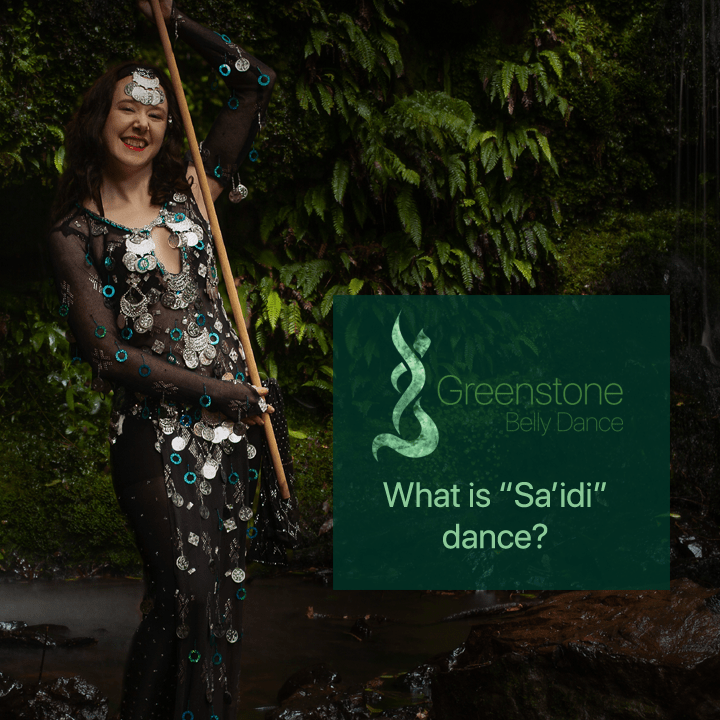What is “Sa’idi” dance?

As belly dancers, we refer to a dance performed to music from the Said region (upper/Southern Egypt) as sa’idi. The more correct name for this dance is raqs-al-assaya/raqs-al-assayah (sometimes transliterated differently), which means stick dance.
Raqs-al-assaya is based off tahtib (sometimes transliterated as tahteeb), an activity performed by men from the Upper Egypt region that is often likened to a martial art form.
Since 2016, Tahtib has been incsribed by UNESCO as an Intangible Cultural Heritage of Humanity. Here is what the UNESCO website has to say about tahtib:
“It involves a brief, non-violent interchange between two adversaries, each wielding a long stick while folk music plays in the background. Complete control must be exercised as no striking is allowed. Practitioners are male both young and old, mostly from Saeedy populations in upper Egypt, particularly rural areas where the tahteeb stick has been used by inhabitants as part of their daily lives and considered a sign of manhood.”
Tahtib is a really unique movement form, so it can be hard to explain it without showing it! Here’s an example of tahtib here:
Mahmoud Reda took field trips in the mid 1960s to collect inspiration for his dance troupe, one of the national troupes of Egypt, the Reda Troupe. Farida Fahmy was one of the principal dancers of this troupe for a very long time, and she has a whole lot of articles on her website (available in multiple languages! But unfortunately I don’t see Dutch) about the Reda Troupe. You can find the articles by Farida Fahmy here.
She says this of their field trips to influence dance creation for the troupe:
“His aim was not to research the indigenous dance traditions and events that he witnessed for any ethnographic purpose. His adaptations were never meant to be literal replicas of the indigenous dances that he witnessed and documented. Collecting material was primarily to find inspiration and to discover the potentials that traditional dance could offer for the stage.”
The Reda Troupe then performed raqs-al-assayah, and specifically something they called Al-assayah al-Gadida (the new stick dance). In the beginning, it seems mainly men in the Reda Troupe danced with sticks, and women danced mostly without.
However! You can see a very famous group of traditional performers, the Banat Mazin, dancing with sticks here:
And a modern video of Khairiya and Raja Mazin with sticks here:
And another modern video of Khairiya:
And even Farida Fahmy dancing with Mahmoud Reda and sometimes taking hold of his stick for the dance here in a very stylised staged interpretation:
And in a recent video of the modern Reda Troupe in 2012, you’ll see the ladies take hold of the sticks very, very briefly at the end of the dance:
More Howevers! Nowadays, female belly dancers or Middle Eastern style dancers do often dance raqs-assaya with a stick. Here’s a good example of a group of dancers of different genders dancing raqs-assaya in a masculine style:
Dancers can choose to dance with the stick and be representing the masculine style of dance (Go feminism, amirite?) OR Dancers can choose to dance with the stick and put a feminine take on it, sometimes presenting in this “belly dance-y” way where they are much more isolated, poised, and reminiscent of belly dance.
See below for a modern version of this:
And a classic of Mona El Said:
And sometimes they’ll actually present it in a way like they’re poking fun at men and their “big sticks!”
The Rhythm
Makloub (aka Saidi) used in the Said region for Tahtib and Raqs al-Assaya
1-+-2-+-3-+-4-+-
D-T-_D-D-_T-_
Other Stick Dances
Be aware: The presence of the stick itself doesn’t necessarly mean dance from Said/raqs-assaya… Don’t worry, I’m still learning all the differences too! It could be baladi with a cane, or it could be Lebanese cane dance.
Baladi with cane:
Lebanese cane dance:
Want to learn raqs-al-assaya?
I, Siobhan Camille, will be teaching an in-person, outdoor raqs-al-assaya class in Delft, the Netherlands this August at part of our annual Summer School! Find the full schedule and details here. If you’re based outside of the Netherlands, I’m available for private online lessons via Zoom, with our professional audio-visual set up.
Have fun continuing to learn about raqs-al-assasya!
